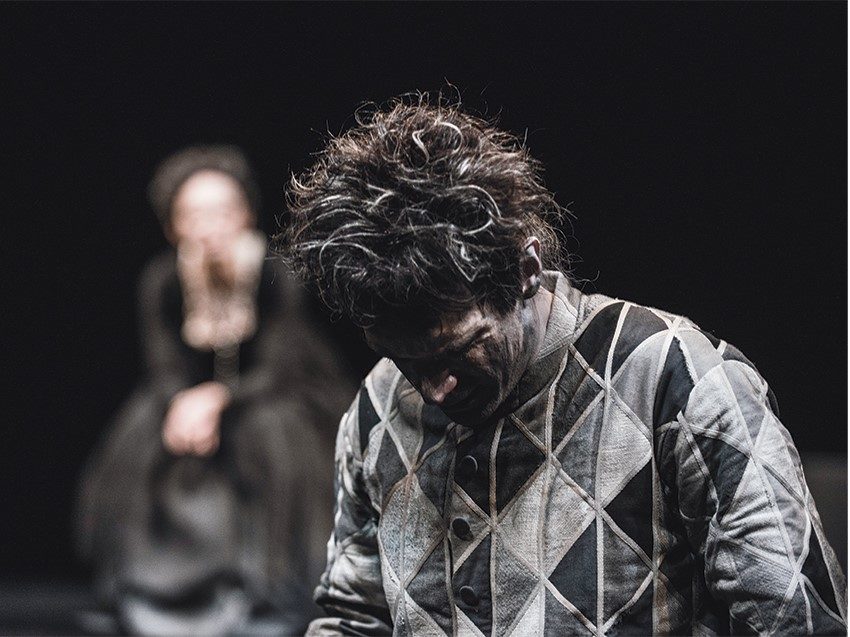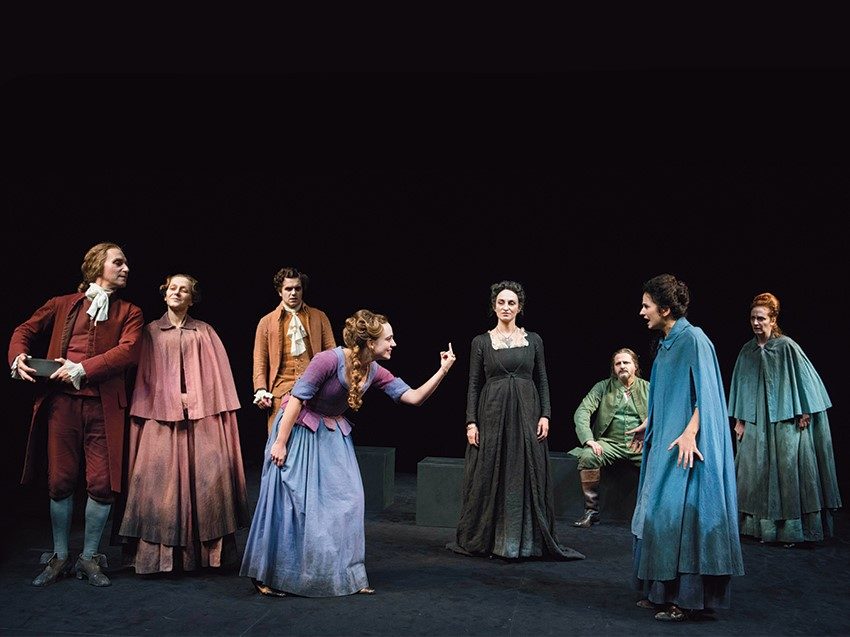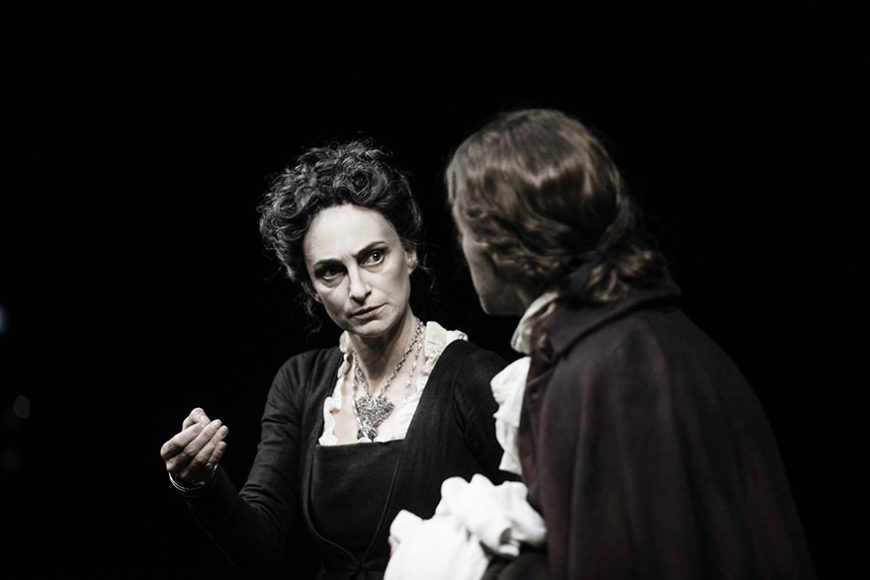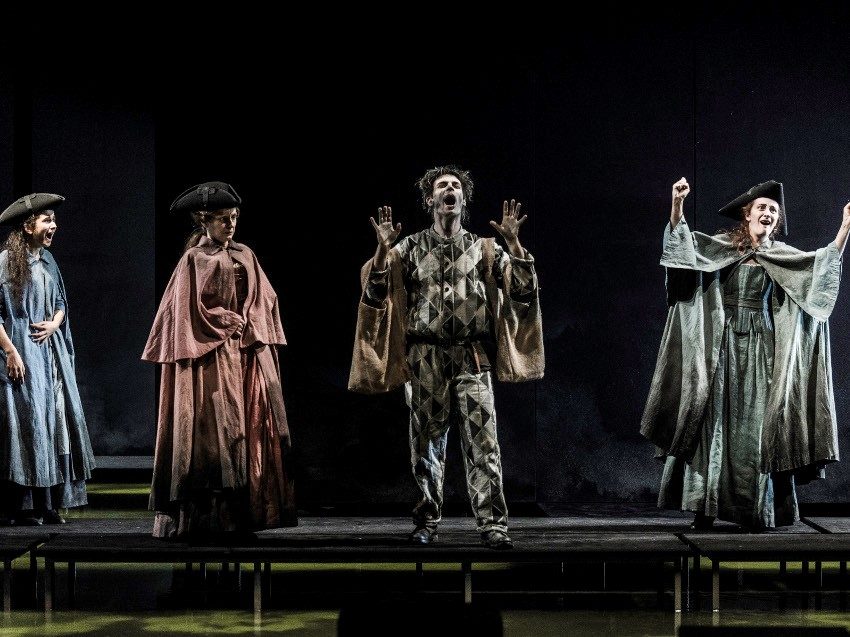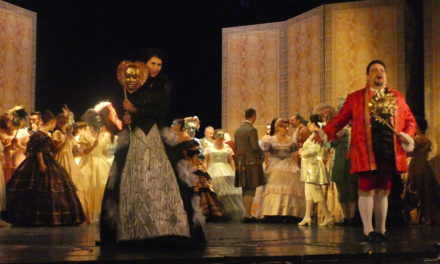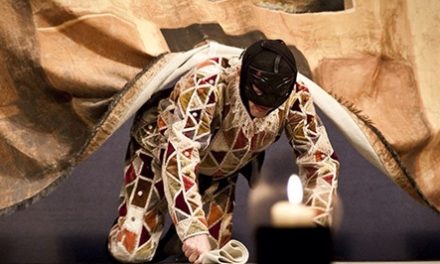The Venice of Goldoni’s The Jealous Women (Le donne gelose) is a city in full decline: the impoverished middle class has withdrawn into its arrogant pride, incapable of accepting the new emergent classes and the decay of its traditional values. In Sangati’s performance this feeling of corruption and downfall appears characterizing and peremptory, impregnating deeply the setting – and consequently the scene.
The scenic design is an overt homage to the austere minimalism of Luca Ronconi: the houses are severely rectangular, monochrome scenery flats; and the only stage objects are the parallelepipeds that work as benches. Under the typical sobriety of Ronconi, nevertheless, there is spread an inquietude which is totally innovative.
In the first place, this spare scene appears claustrophobic: the alleys imprison the characters in a labyrinth from which the flats block the path to the exit. The effect of imprisonment is exacerbated by the position of the audience, which encircles the scene, peeking at it from above, as though closing the characters in a cage.1
But above all, this Venice is submerged in water. The canals, one of the most fitting scenic intuitions, besiege the houses: the interiors themselves are threatened by them, and in the exteriors the characters move on platforms brushed by the water, in continuous danger of falling into it. Water is not only the image of the decline of the city; it works also as a mirror: on its surfaces the figures of the characters multiply and reflect themselves, as though imprisoned in a labyrinth of mirrors. The canals become an exteriorisation of the mental cage of the characters, incapable of looking outside themselves, and consequently trapped in their own obsessions.
Like the city, these characters too are listless, opaque like the colours of the costumes they wear. There is nothing left in them of the types of the Commedia dell’Arte: they are psychologically deepened characters, impregnated with anguished illnesses and obsessions, the men corrupted by the vice of gambling and the women by a ridiculous and senseless hysteria, marked by the recitation.
It’s a society which no longer leaves room for fun. The period of the setting is the Carnival, but the characters seem not be aware of it or not to be able to live its party atmosphere. The masks are now used to hide and fake one’s identity. Sangati pushes this idea to the limit, by transforming them into mortuary masks: so the characters at the foyer wander like spectres with skeleton faces, which cause everything but laughter, figures of their own interior death.
The only one who seems to be at ease in this new world is Lugrezia (in a fitting interpretation by Sandra Toffolatti), the widow who has intercepted the new tendencies of Venetian society at the end of the eighteenth century and has made money her religion. Indeed, her costume is black like the city: she is the only one who seems to be in perfect harmony with it. She is the only one who comprehends its wrongs and deceits and is able to manipulate them to her advantage, instead of limiting herself to the ridiculous agony of the others.
From the ancient types of the Commedia dell’Arte the only one left is Harlequin: but he is an unrecognisable Harlequin. He has lost the mask which distinguished him and the colours of his costume: he face is blackened and dirty, as though contaminated by the soot which envelops the city. He finds himself lost and desperate in a world which he no longer recognizes as his own, whose rules he doesn’t understand and in which his ability to adapt and his shattering positivity are no longer of help. He clings to Lugrezia, with naivety and genuine admiration, pleading with her insistently not to drive him away: he is conscious that his old abilities are no longer required, but he doesn’t want to resign himself to die. The veneration towards Lugrezia is the attempt to cut for himself a space within the reformed theatre – an attempt which Sangati represents as anguished and unsuccessful. The Harlequin who follows Lugrezia like a puppy, forcing himself to laugh and jump like he would have done in a traditional comedy, with an effect of jarring melancholy, has been able perhaps to remain alive – but the price has been to lose himself.
Note
1 The present analysis refers to the performance staged in the spaces of the Piccolo Teatro (Studio Melato), in Milan. The visual effect of the scenic design was studied considering the possible adaptations on tour, with differences the result of adapting the play to different typologies of stages: in particular, it loses much of its pregnancy when the audience is situated in front of and below the stage.
This post was written by the author in their personal capacity.The opinions expressed in this article are the author’s own and do not reflect the view of The Theatre Times, their staff or collaborators.
This post was written by Layla Colamartino.
The views expressed here belong to the author and do not necessarily reflect our views and opinions.

